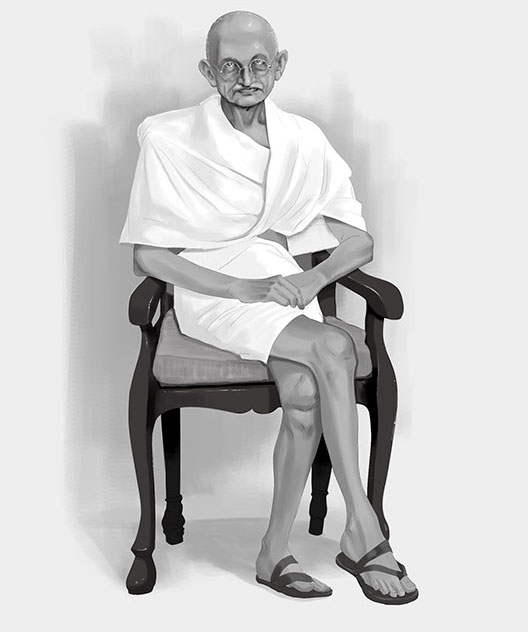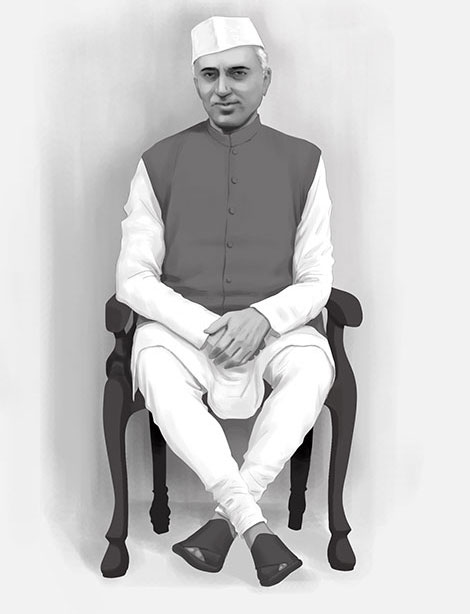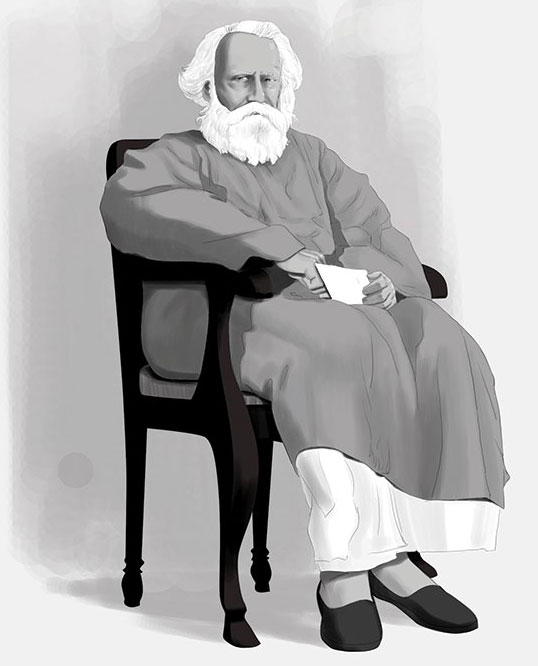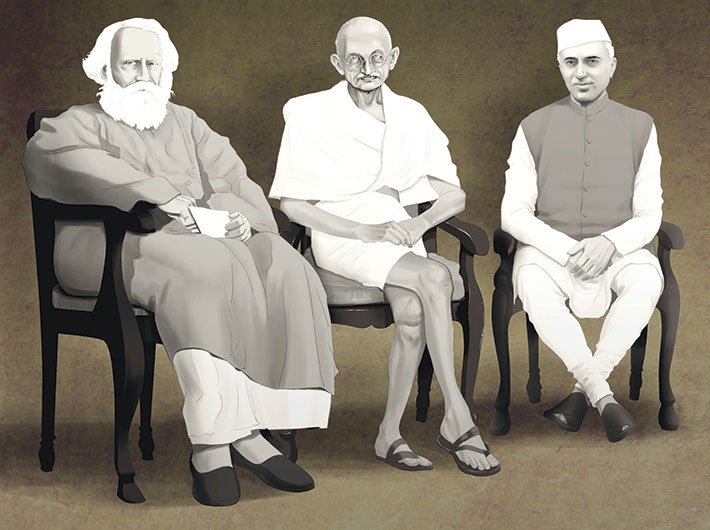Some of the developments in India during the past four years, such as lynchings, growing polarisation among communities on caste and religious lines in every walk of life and the consequent fear psychosis that it has entailed have damaged the social fabric of Indian society. There also appears to be strange emphasis on narrow versions of nationalism that lead to politics of hate build around ‘us’ versus ‘others’. Sectarian nationalism can be readily deployed as a sharp tool to silence critics of official policies by dubbing them as “anti-national”.
Thanks to negativity generated by fake news, generated by virtually all political groups through social media, there is a perceptible loss of compassion in social life. Amidst this atmosphere of intolerance and hatred, any form of critical learning is becoming dormant as it is constantly under challenge.
These circumstances can make anyone nostalgic about ideas and thoughts of towering personalities such as Mahatma Gandhi (1869-1948), Jawaharlal Nehru (1889-1964) and Rabindranath Tagore (1861-1941) that visualised the idea of India and its potential role in Asia and the world on a much wider and nobler scale. Incontestably Dr BR Ambedkar (1891-1956) too was an outstanding visionary whose revolutionary idea of India was premised on total annihilation of hierarchical caste based society in India. However, for reasons of expediency, Ambedkar is being conveniently appropriated by every possible political grouping and as a result he continues to earn unprecedented and iconic posthumous recognition in contemporary India. Indeed, Ambedkar’s ideas on India would warrant a separate inquiry. However, in the present context, it would be certainly worthwhile to revisit some of the ideas of Gandhi, Nehru and Tagore to demonstrate how humanist and not narrow sectarian nationalist ideas have positively contributed in shaping the idea of India.
Conscious of the fact that India has been an old civilisation, Gandhi, Nehru and Tagore intrinsically were working towards building a more civilised and peaceful world. The term ‘civilization’ signifies an entity with an advanced stage of human development. Any civilization is capable absorbing a substantial number of human beings from diverse religious and cultural backgrounds owing to a wide variety of intricately complex web of ties between the people. Thus, civilization also presupposes culture that gets manifested through art and science of governance, politics, education, science, religion, philosophy, metaphysics, fine arts, architecture and even code of ethics. Among the prominent Asian civilizations Buddhist, Islamic and Hindu civilizations have survived cutting across the conventional barriers of political states and nations for many centuries.
I believe that civilizations have capacities to integrate and synthesize diversity of ideas, thoughts and cultures because they embody confluence of diversities. Indeed, India’s civilization and society has been enriched by all other civilisations. For instance, India has been geographically as also culturally connected to practically all the other regions of Asia. Prolonged exchanges in terms of ideas as well as trade between India and all these regions for centuries have surely been mutually beneficial. India has interacted with southern and eastern parts of Africa through maritime routes for centuries. Moreover, Asia’s encounter with European colonial powers of the West, in several ways, had challenged settled ways of thinking in Asia. Hence, synthesizing ideas from the west and the east also has preoccupied minds of thinkers on either side. In a way encounter with the west did produce hybrid/Euro-Asian or Euro-African identities in Asia and Africa. Interestingly, Gandhi, Nehru and Tagore owing to their breadth of exposure to different civilisations of the world were able to build cosmopolitan and international outlook while building India of their dreams. Let me reflect on their ideas and contributions in the same order.
Gandhi

At one level, Gandhi can be best understood in the context of imperialism owing to his innovative strategy to counter the British imperial power in South Africa and India. Gandhi’s notion of justice certainly embraced ‘self-determination’ as a fundamental right of the oppressed nationalities under the aegis of imperialism. In order to attain this basic human right, Gandhi chose to spiritualize politics by his relentless quest to reach closer to truth through non-violent methods. His praxiological commitment to truth and justice coupled with his constant emphasis on unity between being and doing made him a unique thinker. Gandhi could build a mass movement of mammoth proportions due to his unprecedented following from diverse social and religious groups in India. How could he build such a following? How did he negotiate social and religious diversities?
Indeed, Gandhi could easily reconcile and negotiate with religious, social and cultural diversities of India. Porbandar, where Gandhi was born and brought up, has been inhabited by Arab, Sindhi, different Islamic sects such as Khojas, Aga khanis, Asna Ansaris as also Hindu, Jain and Parsi communities. It provided fertile ground for Gandhi to deal with and even synthesise religious diversities. By respecting all other faiths and co-existing with them Gandhi remained a proud orthodox Hindu. Teachings of Bhagvad Gita and Bhakti movement in medieval and modern India have had enormous impact on Gandhi’s personality. He not merely tried to understand and practise the teachings of Gita but used Bhajans from Bhakti movement to promote India’s freedom struggle. One of the meaningful bhajans written by Narsinha Mehta, a poet saint from Gujarat of the 15th century, was extremely popular during the freedom struggle and was sung by the Satyagrahis while they, along with Gandhi, were going on a protest march to Dandi in the famous Salt Satyagraha in 1930. The Bhajan conveyed that only those people are truly religious who are sensitive to others’ sufferings.
The question that arises is whether India is a deeply spiritual country where inter-faith dialogue is possible and has existed all along? For instance, Kabir, a poet-saint of the 15th century, criticised hypocrites among Hindus as well as Muslims. Both Islamic as well as Hindu traditions of thoughts co-existed in Kabir. He also influenced Sikhism and the Bhakti movement. Similarly, Sufi thoughts, syncretic values and literature have had enormous influence in South Asia for almost one thousand years. Gandhi’s persona somewhere needs to be understood in the same context. Gandhi combined compassion of Buddha and passion for truthfulness of Christ. His humane outlook prompted him to carry everyone along with him. Evidently, Gandhi also was an unrepentant champion of Hindu-Muslim unity in India. He eventually had to shed his life for holding on to this conviction in 1948.
Through his sustained experiments with truth in South Africa (1893-1915) and later in India, Gandhi strove to build ‘soul force’ as against brute force, represented by imperialism, on the basis of collective spiritual vitality. By fighting on the basis of truth and nonviolence Gandhi also meant to reach God. He never distinguished between God and truth. He also perceived the existence of God within every living being and hence all over. Moreover, he regarded Islam to be a religion of peace in the same way as Christianity, Buddhism and Hinduism are. His religio-spiritual orientation implied inter-religious dialogue with a humanist touch. In India, for the past few years as politics of intolerance is prompting religious communities to hate each other, one invariably remembers Gandhi. Leaders like Gandhi or Azad were deeply religious but not communal. For, demonising any specific religious community is a crime against humanity. India needs to grow more tolerant and humane.
As a thinker, Gandhi was critical of acquisitive, materialist and inhuman tendencies that dominated Europe after industrialisation. He was equally ill at ease with the drive of industrial powers, with imperial ambitions, to ceaselessly denude earth by exploiting its resources. His quest for an environmentally and ecologically friendly world inevitably prompted him to oppose uncritical acceptance of the western modes of development. Neither Adam Smith’s notion of self-serving man nor Darwin’s thesis of survival of the fittest appealed to him. He constantly negotiated with the western civilization, even learnt from it and yet critiqued it as well. Gandhi drew from the writings of Mazzini, Thoreau and Ruskin among the western thinkers of the Nineteenth century who were dissenting against the then official establishment. Mazzini’s famous work called, ‘The Duties of Man and Other Essays’, inspired him to build his notion of nationalism that gave importance to duties, as against the rights, vis-à-vis a larger community. Further, he learnt the techniques of passive resistance or civil disobedience from Thoreau and he had translated Ruskin’s work, ‘Unto This Last’, in Gujarati with the title ‘Sarvodaya’, meaning wellbeing of all. He also learnt a great deal from Russian thinkers of the Nineteenth and early Twentieth century such as Blavatsky, Bondariev, Tolstoy and Kroptokin regarding status of peasants in Russia. On the basis of his study he tried to compare the status of peasants in Russia with those in India.
In substance, Gandhi had an all-encompassing world view from ‘washing of the pots to the fate of the empire’. His critics have underscored impracticability of his ideas, his unscientific approach to human problems and moral stances that he recurrently and obstinately embraced to counter his opponents within the freedom movement. However, in contemporary times where we see destruction of environment, violence among communities as well as nationalities and growing loss of faith in fair means with concomitant rise of criminals in politics, Gandhi becomes all the more relevant. His peaceful and dialogic method and diagnostic attitude to resolve social problems could only facilitate inter-community and inter-civilizational interactions.
Nehru

As a thinker, Nehru combined two distinct philosophical streaks – Fabian socialism and Gandhism. He imbibed and synthesised within himself democratic and egalitarian societal visions of the Fabians and Gandhi’s unshakable faith in fair, peaceful and nonviolent means to achieve his ends. He virtually shaped the notion of building a modern, secular and democratic India.
Trained in the west, Nehru was an agnostic who believed in secularism and promoting scientific temper. Secularism in the Indian context meant equal respect for all religious faiths. Nehru had a feel as well as sense of history. He wielded his pen like a gifted artist while writing a moving and eminently readable prose. He chose to unravel, quite passionately, the richness of India’s civilization in ancient, medieval and modern times through his celebrated work, ‘The Discovery of India’. Nehru’s idea of India was inclusive. He always argued that different communities with diverse faiths peacefully co-existed in a geographical space of India and hence India could be treated as a natural microcosm of the world. Indeed, dream of unity, in his view, had haunted India from the dawn of civilization.
Nehru argued that an attitude of tolerance or ‘live and let live’ has characterised India’s old civilization. He unravelled how a wide range of diversities among Indian people were delicately tied up with the threads of unity in India. What is more, in the same book he described China as an old Asian civilization. Nehru’s capacity to synthesize civilizational diversities, respect for tolerance as a value and ceaseless quest to run India on the basis of consensus laid the foundations of our multi-party democracy. Evidently, the Nehruvian idea of India has always subsumed trans-cultural and even trans-civilisation dialogue of all diversities within India and between India and all the other parts of the world. Basically Nehru’s emphasis on internal harmony among communities in India is squarely missing today.
Besides, Nehru was an institution builder and an architect of modern India. Institutions of democracy such as the parliament and judiciary were strengthened during his regime. Due to internal democracy the Congress party functioned as a system on the basis of consensus. Institutes of management and technologies and civil services were also consolidated during his regime. Gigantic dams like Bhakra Nangal and steel plants were turning India into a modern country. Similarly, he had capacities to contain sectarian, jingoistic and chauvinistic forces. However, the Nehruvian project of development was skewed as it really failed to strike a balance between industry and agricultural development, higher and primary education and urban and rural development.
In external relations, Nehru often emphasised the strategic nature of India’s geographical and cultural location that linked the country to eastern, northern, western and south-eastern Asia. He viewed India as a pivot or hub of Asia. Thus, whatever happened in Asia India was affected by it and whatever happened in India Asia was affected by it. Being a peninsula, India has had to be a maritime power as well as a continental power. Indeed, Nehru’s claims about India’s status could be contestable as China could as well define itself as the hub of Asia. Nevertheless, Nehru’s commitment to forge pan-Asian ties was incontestable.
When we talk of this century as Asian century perhaps we have to think of pioneering leaders like Nehru who laid the foundations of pan-Asianism. On the eve of India’s independence, Nehru had successfully organised the Asian relations conference in New Delhi in March-April 1947. Through the conference he endeavoured to define the likely role of India in Asia on the one hand and worked towards delineating what could constitute a pan-Asian identity, on the other hand. Being one of the first countries that attained freedom after World War II, Nehru perceived that independent India had to play a larger role beyond its borders and that a shadow of India’s ‘soothing presence’ will revive inter-Asian ties that had been broken off under the British colonial rule. While launching the state and its sovereign power in India, Nehru chose to build Asian identity on the planks of civilizational pride and opposition to colonialism and racialism. He moved with a conviction that India and Asia were emerging on the world scene to assert their presence in order to live with dignity and self-respect. India under Nehru chose to steer clear of power blocs in the Cold War and followed the policy of non-alignment. Simply put, non-alignment was a logical extension of India’s nationalism and its right to enjoy freedom of expression in international relations. As a non-aligned country India and Nehru played a major mediatory role between the East and the West during the Korean (1950-53) and Indochina (1954) crises. Subsequently, during the historic Afro-Asian conference of Bandung in 1955, Nehru took initiative along with other Afro-Asian leaders to push the demand for the termination of colonialism and racism. In fact, the Bandung conference also formed the basis of south-south cooperation in the later years. After the Bandung conference, the cry for self-determination among the colonised countries got a wider support. To an extent, the Bandung spirit did contribute positively to a formal process of decolonization in Afro-Asia.
It also needs to be underscored that policy of non-alignment was used by Nehru as a vehicle to serve India’s vital national interests. Non-alignment initially started as a policy; then it became a broad strategy and eventually emerged as a sub-system in international relations after the Belgrade conference of non-aligned countries in 1961. To put it more graphically, India was the actor, non-alignment was the political script and world was the stage. The Belgrade conference also led to the establishment of the Non-Aligned Movement (NAM) which has 120 member states and 24 observer states by now. In short, Nehru’s representation of India and Asia on the one hand was designed to define identity of a newly emerging sovereign power of India and on the other hand it also consistently made a broader political statement by interweaving civilizations on ethical and moral grounds as it upheld denuclearisation, disarmament and decolonisation as important conditions to pursue international relations harmoniously.
Tagore

If Gandhi and Nehru were political leaders, Tagore was a poet laureate, educationist and philosopher. A humanist to the core, he spoke for the mankind. He travelled across Asia, especially East Asia, and the rest of the world, and visited almost thirty countries from 1878-1932. His contributions in the field of literature have proved immortal. I believe his thoughts on nationalism are worthy of consideration even in our times. Tagore had expressed his reservations on the idea of nationalism in 1917. If nationalism was the dominant force in those days, Tagore had the necessary nomadic restlessness to rebel against the settled tradition. He had also condemned the persecution of Jews under Nazi Germany (1933-45). Tagore expressed a grave concern over the manner in which his friend Albert Einstein, a German Jew, was treated. Einstein had renounced his citizenship for political reasons to seek refuge in the USA in 1933. Indeed, in contemporary times ethnic nationalism of majority community is not able to restrain the politics of hate against ethnic, racial and religious minorities in many parts of the world. Hatred is like inner cancer and it can destroy individuals, societies and civilisations. The essence of Tagore’s famous essay titled ‘Nationalism in India’ could be placed thus.
Tagore was writing on nationalism when Europe was preponderant in the world. He observed that Europe is not merely conscious of the fact that European is ‘Western’ but it never loses an opportunity to hurl this fact against others to humiliate them. Such an attitude of apathy and contempt is natural in an abnormal relationship that is based on national selfishness and pride. India in this sense never had a spirit of nationalism although in his childhood Tagore was taught that reverence towards nationalism is greater than reverence towards God. He outgrew such feeling through education as he realised that no country can be greater than the humanity. He believed that no form of patriotism or nationalism can offer a final spiritual shelter. He was also aware of the fact that India could not have lived with borrowed weapons of civilisation (European) that could be stifling. He was aware that undue pride and self-interest that entail nationalism can degrade anyone.
Tagore boldly moved ahead to crack a myth that people are free in the west. On the contrary, he asserted, majority is not free from ‘the powerful’ anywhere and unfortunately is driven by minority to a goal which is not even known to them. Tagore loved nature and opined that its vast powers are never revealed in hideousness but in beauty. Tagore was perennially in search of beauty and truth. He believed that on the basis of truth and beauty mankind can be served and great civilisations can be built. In his view, beauty and truth require leisure and self-control for their growth. It is easy to make out that Tagore’s world of imagination and ideas had little space for narrow nationalism and hatred. Such sentiments, in their turn, can only facilitate inter-civilisation dialogue.
To conclude, Gandhi, Nehru and Tagore from their own vintage point were letting fresh winds of breeze flow from India into Asia and the world. Such winds were never confined to compounds of narrow nationalism. All these thinkers were mindful of the strengths of India’s ancient civilisation as well as other civilisations in the world. While taking care of India’s interests, their ideas and thoughts proved to be harbingers of a more humanitarian world build on inter-civilisation dialogue. n
Harshé is president, GB Pant Institute of Social Science, Allahabad and former vice chancellor Central University of Allahabad.
(This article is published in January 31, 2019 edition)
